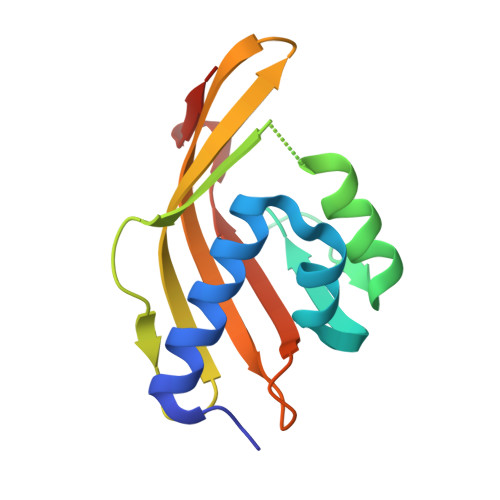Rescue of deleterious mutations by the compensatory Y30F mutation in ketosteroid isomerase
Cha, H.J., Jang, D.S., Kim, Y.G., Hong, B.H., Woo, J.S., Kim, K.T., Choi, K.Y.(2013) Mol Cells 36: 39-46
- PubMed: 23740430
- DOI: https://doi.org/10.1007/s10059-013-0013-1
- Primary Citation of Related Structures:
4K1U, 4K1V - PubMed Abstract:
Proteins have evolved to compensate for detrimental mutations. However, compensatory mechanisms for protein defects are not well understood. Using ketosteroid isomerase (KSI), we investigated how second-site mutations could recover defective mutant function and stability. Previous results revealed that the Y30F mutation rescued the Y14F, Y55F and Y14F/Y55F mutants by increasing the catalytic activity by 23-, 3- and 1.3-fold, respectively, and the Y55F mutant by increasing the stability by 3.3 kcal/mol. To better understand these observations, we systematically investigated detailed structural and thermodynamic effects of the Y30F mutation on these mutants. Crystal structures of the Y14F/Y30F and Y14F/Y55F mutants were solved at 2.0 and 1.8 previoulsy solved structures of wild-type and other mutant KSIs. Structural analyses revealed that the Y30F mutation partially restored the active-site cleft of these mutant KSIs. The Y30F mutation also increased Y14F and Y14F/Y55F mutant stability by 3.2 and 4.3 kcal/mol, respectively, and the melting temperatures of the Y14F, Y55F and Y14F/Y55F mutants by 6.4°C, 5.1°C and 10.0°C, respectively. Compensatory effects of the Y30F mutation on stability might be due to improved hydrophobic interactions because removal of a hydroxyl group from Tyr30 induced local compaction by neighboring residue movement and enhanced interactions with surrounding hydrophobic residues in the active site. Taken together, our results suggest that perturbed active-site geometry recovery and favorable hydrophobic interactions mediate the role of Y30F as a secondsite suppressor.
Organizational Affiliation:
Department of Life Science, WCU Program, Pohang University of Science and Technology, Pohang, 790-784, Korea.














